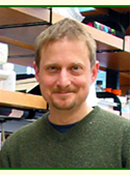Eric L. Weiss Signaling pathways in the control of cell architecture
Research Interests
Eukaryotic cells exert remarkable control over their three-dimensional organization. This control of morphogenesis is central to cell division, motility, and differentiation, and requires orchestration of diverse processes. My laboratory is interested in understanding how protein kinase signaling pathways coordinate cytoskeleton organization, membrane traffic, and gene expression to define cell architecture. We are using the budding yeast Saccharomyces cerevisiae to determine the exact physiological functions and relevant phosphorylation targets of highly conserved kinases that control important aspects of cell morphology.
Our present work is concentrated on understanding the functions of p21-activated kinases (PAKs) and the Ndr/warts family kinase Cbk1. The PAKs are important in early bud formation and establishment of the cytokinesis site, and may have undefined functions during late cell division. We are investigating PAK regulation of cytoskeletal proteins important for bud morphogenesis. Cbk1 is required throughout the cell cycle for sustained polarized growth, and may control localization of cell wall modifying machinery. Interestingly, Cbk1 also coordinates the transcription of genes required for mother/daughter separation with exit from mitosis. This function likely involves regulation of the nuclear export of Ace2, a highly conserved transcription factor.
Understanding how any protein kinase relays information requires identification of its regulatory partners and downstream phosphorylation targets. We are taking diverse approaches to this difficult problem. In addition to well-established genetic and biochemical techniques, we are using novel chemical genetic methods for in vivo and in vitro characterization of individual protein kinase functions and targets. This work involves both careful phenotypic analysis and proteome-scale investigation of potential phosphorylation targets.
Selected Publications
The Structure of an NDR/LATS Kinase–Mob Complex Reveals a Novel Kinase–Coactivator System and Substrate Docking Mechanism. Gógl G, Schneider KD, Yeh BJ, Alam N, Nguyen Ba AN, Moses AM, Hetényi C, Reményi A, and Weiss EL. PLoS Biology. 2015 May 12;13(5):e1002146.
Detecting Functional Divergence after Gene Duplication through Evolutionary Changes in Posttranslational Regulatory Sequences. Nguyen Ba AN, Strome B, Hua JJ, Desmond J, Gagnon-Arsenault I, Weiss EL, Landry CR, and Moses AM. PLoS Computational Biology. 2014 December 4;10(12):e1003977.
Cell Morphogenesis Proteins Are Translationally Controlled through UTRs by the Ndr/LATS Target Ssd1. Wanless AG, Lin Y, and Weiss EL. PLoS ONE. 2014 January 21;9(1):e85212.
Cell Cycle Regulated Interaction of a Yeast Hippo Kinase and Its Activator MO25/Hym1. Hsu J and Weiss EL. PLoS ONE. 2013 October 21;8(10):e78334.
Mitotic Exit and Separation of Mother and Daughter Cells. Weiss EL. Genetics. 2012 December 1;192(4):1165-1202.
View all publications by Eric L. Weiss listed in the National Library of Medicine (PubMed). Current and former IBiS students in blue.
